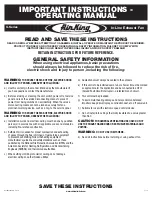
INSTALLATION INSTRUCTIONS
CAUTION:
MAKE SURE POWER IS SWITCHED OFF AT SERVICE PANEL BEFORE
STARTING INSTALLATION.
SECTION 1
Preparing the Exhaust Fan
1. Unpack fan from the carton and confirm that all pieces are present. In addition to the
exhaust fan you should have:
POWER UNITS
KITS
1 - Blower
1 - Blower
1 - Mounting Bracket
1 - Mounting Bracket
1 - Instruction/Safety Sheet
1 or 2 - Room Inlet with Grill
1 - Instruction/Safety Sheet
2. When selecting fan mounting location, the following criteria should be considered:
a)
Mounting to minimize noise generated by fan operation:
Mounting the fan as
far as possible from the intake point will minimize fan operating noise from being
transmitted back through the duct work. If the fan is to be used as a booster
for moving the air between two rooms, a central point along the duct may be
optimal. Insulated flexible type duct work (recommended for all bathroom exhaust
applications) will result in much quieter operation. It is recommended that a
minimum 8' of insulated flexible ducting be used between any exhaust grill and
fan for low noise level.
b)
Service accessibility:
Fan location should allow sufficient access for service.
SECTION 2
Installing the Fan
1.
Attach the included mounting bracket to the wall stud or ceiling joist. Connect the fan to
the moutning bracket using the included screws
(Figure 1).
NOTE:
Fan mounting can be at any point along the duct and in any angle, however, vertical
mounting is recommended to reduce condensation buildup in the fan. If a horizontal
installation is necessary and condensation buildup may pose a problem, wrap insulation
around the fan to minimize buildup.
SECTION 3
Room Inlets (Included with Kits Only)
New Construction
1. Using the gauge on the fan’s housing
(Figure 2)
, line up housing so that it will be flush
with the finished ceiling or wall. Position the fan so that the tabs rest flat against the joist
or stud and secure with four nails (not provided) to ensure proper installation.
www.airkinglimited.com
A210952017 Rev. C 3-14
2 of 8
Existing Construction
1. Position housing against the joist or stud and trace an outline of the housing onto the
ceiling/wall material
(Figure 3).
Set housing aside and cut opening, being careful not
to cut or damage any electrical or other hidden utilities. Place housing next to the joist
or stud and insure that it is flush with the finished ceiling. Secure with four nails (not
provided) to ensure proper installation
(Figure 2).
SECTION 4
Ducting
CAUTION:
ALL DUCTING MUST COMPLY WITH LOCAL AND NATIONAL
BUILDING CODES.
NOTE:
Insulated ducting is required for bathroom exhaust applications, where ducting passes
through unconditioned space or where noise is a factor. Failure to use insulation could result in
excessive condensation buildup within the duct, and undesirable sound levels within the room.
Duct runs should have as few bends as possible.
NOTE:
Flexible insulated ducting may be used where allowed by local code. For the quietest
possible installations, it is recommended a minimum of 8’ of insulated flexduct be used
between any exhaust grill and fan. When using flexible type duct work, duct should be
stretched as tight and straight as possible. Failure to do so could result in dramatic loss of
system performance. Flexible duct should be connected to the fan with screw clamps or duct
tape. All connections should be as airtight as possible to maximize system performance.
1.
Connect one end of the ducting (not included) to the room level collar/damper and the
other end to the “Y” transition. Secure both ends in place using tape or a screw clamp
to create as air tight a seal as possible. Repeat this step for the other room level grill
housing
(Figure 4).
NOTE:
Units that include only one collar do not utilize the “Y” transition. Follow the same
instructions as in step 1, except connect the one end of the ducting directly to the fan.
2.
Connect one end of the ducting to the top of the “Y” transition and the other end to the
intake of the fan
(Figure 4).
3.
Connect one end of the ducting to the exhaust of the fan and the other end to a wall or
ceiling cap
(Figure 4).
Always duct the fan to the outside through a wall or roof cap.
NOTE:
When using insulated flex duct, it is recommended that the inner vinyl core be screw
clamped or taped to the inlet and outlet and that the vapor barrier surrounding the insulation
be taped to the fan housing.
NOTE:
When attaching flex duct to the collar/damper combination and an immediate elbow is
necessary, be certain that the elbow is installed with a “soft” bend to allow damper blades to
operate properly.
Figure 2
Figure 3
Bracket
Figure 1
Joist/Stud
Exhaust to
Wall/Roof Cap
Figure 4
Fan
“Y” Transition
Housing
Ducting
Housing








